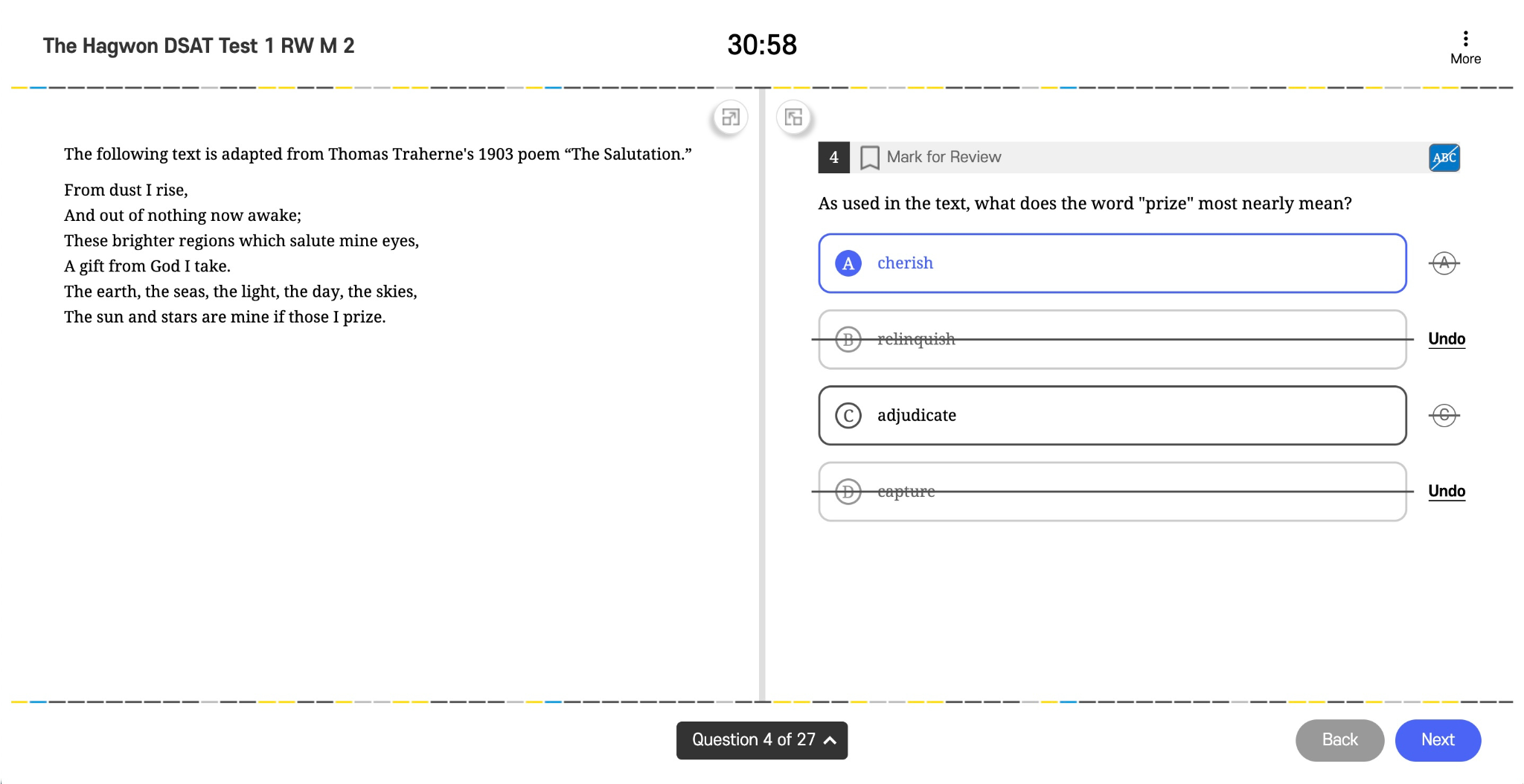Digital SAT
Start Here Your Digital SAT Prep
We know you need help with the SAT,
So we made our website FREE
This is our gripe with the current test prep landscape:
Many students are still excluded from high quality test prep due to economic and geographic barriers.

High Barrier to Entry
Premium tutoring and college counseling services are too expensive and inaccessible for most students who rely primarily on free resources.

Limited Free Resources
Yet free resources, such as Khan Academy or College Board, only scratch the surface of test prep — leaving many students under prepared for SAT test day.

Lack of Guidance
Students often get lost while preparing for the SAT, as much of the information online is too general and inapplicable.
The Hagwon SAT Commandments
The Hagwon Plus+
For those who need official simulations of the real SAT, we also offer various section and test bundles.
These bundles help accelerate students' learning as they feature key concept lectures in the form of question review videos.

Full-Length Practice Test Under Realistic Conditions
- Fully emulated digital testing interface
- From start to end official test-like sequence
- Added support tools: reference sheets, etc
- Question algorithms set in upper module difficulty
- Desmos calculator feature & built-in timer
- Answer Elimination feature for multiple-choice
- Flag questions for review
Which Bundle is right for you?
The Hagwon Question Bank

The Hagwon Question Bank allows students to choose the Section and Question type they wish to practice. Our FREE Question Bank covers all the different types of questions and passages you may see on the SAT and is open to all students with a free account. Want to go the extra mile? Check out The Hagwon Question Bank Mastery Mode for additional practice questions and more customizable features made to make sure you don't waste time studying the wrong thing.
Boost Your Score Bundle

Test day approaching soon? This bundle allows students to prepare all the skills they'll need to showcase on test day. You'll be able to make sure you've thoroughly reviewed all the question types and sections, but also that you have the Bluebook features and tools down pat.
Frequently Asked Questions
In 2023, College Board introduced major changes to both the content of the SAT and how the test is administered. Most importantly, the SAT is transitioning to a fully digital test, leaving behind the traditional paper-and-pencil format. With this change the SAT has also become section adaptive, meaning how you perform on the first module of each section will affect the group of questions you see in the second module. The Digital SAT is also shorter than the paper SAT at just 2 hours and 14 minutes. Other changes include: shorter reading passages, one question per passage on the Reading and Writing section, and access to the Desmos calculator for the entire math section.
The Math section of the Digital SAT covers topics across four categories: Algebra, Advanced Math, Problem-Solving and Data Analysis, and Geometry and Trigonometry. Questions in all four categories come in both Multiple Choice and Student-produced response (a.k.a Free Response) questions. Below are descriptions of the specific topics included in each category:
- Algebra: Analyze, fluently solve, and create linear equations and inequalities, as well as analyze and fluently solve systems of equations.
- Advanced Math: Demonstrate attainment of skills and knowledge central for successful progression to more advanced math courses, including analyzing, fluently solving, interpreting, and creating a variety of equation types.
- Problem-Solving and Data Analysis: Apply quantitative reasoning about ratios, rates, and proportional relationships; understand and apply units and rates; and analyze and interpret one- and two-variable data.
- Geometry and Trigonometry: Solve problems that focus on perimeter, area, and volume; angles, triangles, and trigonometry; and circles.
The Reading and Writing questions of the Digital SAT are organized into four categories: Information and Ideas, Craft and Structure, Expression of Ideas, and Standard English Conventions. All Reading and Writing questions are multiple choice questions. Below are descriptions of the specific topics included in each category:
- Information and Ideas: Command of Evidence (Textual & Quantitative), Central Ideas and Details, Inferences.
- Craft and Structure: Words in Context, Text Structure and Purpose, Cross-Text Connections.
- Expression of Ideas: Rhetorical Synthesis, Transitions.
- Standard English Conventions: Form, Structure and Sense, Boundaries.
All questions available on The Hagwon (including our full-length test bundles, The Lightning Round, and Digital SAT question) are crafted by our expert educators based on the Bluebook tests. However, they are not the same questions available on the Bluebook practice tests nor the College Board Educator Question Bank.
You can find the all the test dates, registration deadlines and other important reminders for the rest of the semester on our downloadable Digital SAT Calendar: https://www.thehagwon.com/resource/library/18
You won’t need a College Board account nor Bluebook to access any of the materials on The Hagwon. However, you'll need to sign in to Bluebook to access the full-length Bluebook digital practice tests. You will also need a personal College Board student account and the Bluebook application downloaded onto your testing device for test day, unless you are taking the test on SAT School Day.